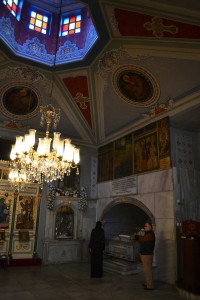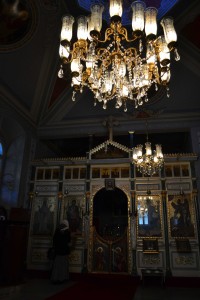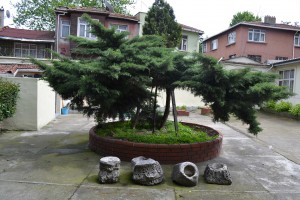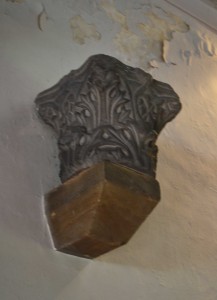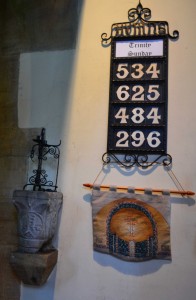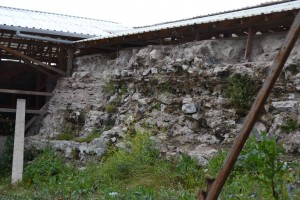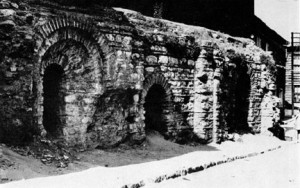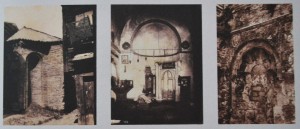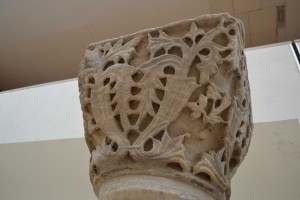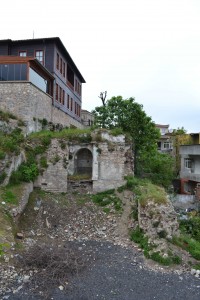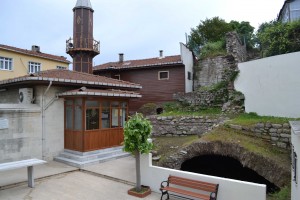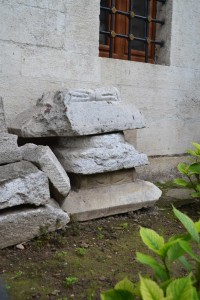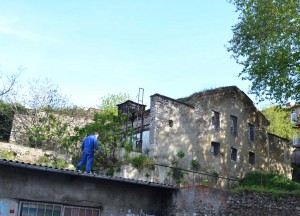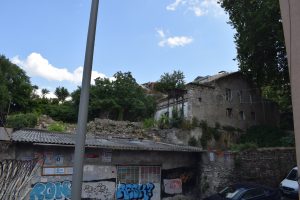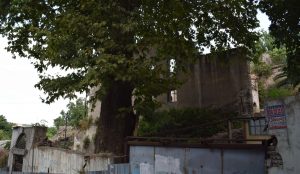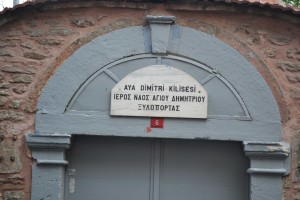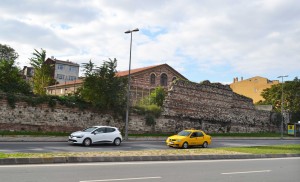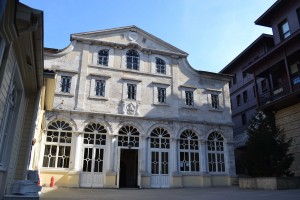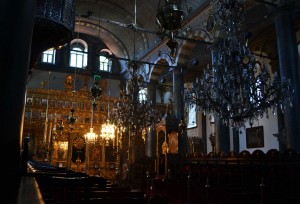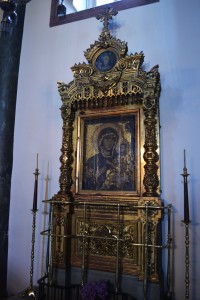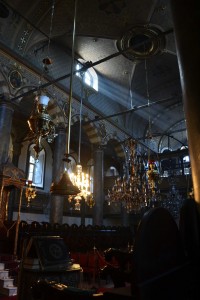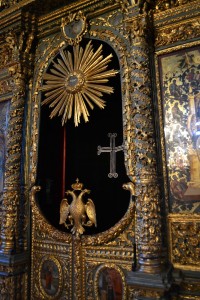In the basement of the modern church is a spring whose waters have been sacred since well before Byzantine times (41.038461,28.942564). Pilgrims still come to partake of the healing water. The modern church is ugly from the outside but the interior, which is what matters, is a haven of peace and sanctity. The gardens are beautiful and there is a lovely Greek café on the corner outside the gate.
There was a massive Byzantine church here from 451 to 1434. It used to house the mantle and robe of the Virgin Mary and was considered by some to be the most holy site in Constantinople. There are some Byzantine bits in the courtyard that might come from the old church. The caretaker is taciturn but loves his church and will answer questions.
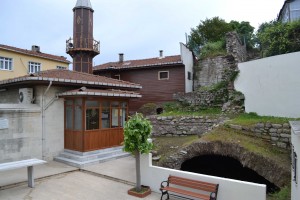
Immediately behind the present church is this section of vaulting, apparently from Blachernae Palace and possibly from the Byzantine church.
These two capitals are in the eccentric Church of the Holy Wisdom in Lower Kingswood, Surrey. They are said to be from the Byzantine Church of Blachernae.

Posted June 27, 2014 Posted by Adam in Uncategorized
There is a wall inside the construction site for whatever the Belediye is doing to Ivaz Efendi Camii and the towers behind it (41.039432,28.941786). This may be the remains of the Church of St Thecla, converted into a mosque from the Byzantine building. Another candidate for the site of this church is the defunct Toklu Ibrahim Dede Mescidi, the site of which is in a housing estate under construction near Ayvansaray Gate. However, the Church of St Thecla stood within the Palace of Blachernae. Firm evidence for the location of the church will probably never be found, but this Byzantine wall appears to be in the right place. Van Millingen provides an exhaustive summary of the arguments up to 1912.
There is a tenuous argument that Toklu sounds like Thecla so the mescid that once stood in Ayvansaray must have been the remains of the Church of St Thecla. This will only convince you if you want to be convinced of it. A look at Van Millingen’s pictures from around 1912 will show how much of Toklu Dede stood in the early twentieth century. Any remains are now beneath other buildings. This site shows the disappearance of the remaining wall in and around 2012.
I could only take the picture by poking a small camera through a hole in a steel fence and hoping for the best. While I was doing this, a nice turbaned man with three ladies swathed in black (his wife and his sisters) arrived and asked for an explanation of what I was doing. They seemed very interested but their faith in my sanity was damaged when they later saw me photographing an exposed bit of foundation near Eğri Kapı. The exchange went like this:
Man: What’s this?
Me: I don’t know.
Man: Why are you taking photographs of it?
Me: I might find out what it is later.
He walked away smiling and shaking his head. Shortly afterwards, I heard the tinkling of veiled female laughter.
In 2014, the Byzantine structure in the photograph below was visible. It was uncovered during municipal clearing of illegal housing. It is now inaccessible again and guarded by dogs that seem prepared to back up their threats. It lies below the nicely reconstructed Buharlı Emir Tekkesi which is immediately across the road from the ruins usually associated with the Church of St Thecla. Minimal information is here.
Fatih Haber (2014) Tamamı SIT Alanı Fatih Böyle Dönüşüyor. Available online at: http://www.fatihhaber.com/yazdir.php?id=701&t=H Accessed 8th Jul 2016
Mathews, T. (2001) The Byzantine Churches of Istanbul. Available online at: http://www.nyu.edu/gsas/dept/fineart/html/Byzantine/ # Accessed 8th Jul 2016
van Millingen, A. (1912) Byzantine Churches in Constantinople: Their history and architecture. pages 207-211 Available online at: http://www.gutenberg.org/files/29077/29077-h/29077-h.htm#Page_207 Accessed 8th Jul 2016

Posted June 27, 2014 Posted by Adam in Uncategorized
Underneath the blood red St Mary of the Mongols lies the burnt ruin of a church that served as the orthodox Patriarchate from 1586 until 1596 (41.030331,28.948256). It was the usual basilica type built without dome or towers as dictated by the Ottoman Empire. It was once attached to the palace of the rather interesting Cantacuzene family of Wallachia, which led to it being called Vlach Saray (Wallachian Palace). Or it might be that it is close to the Blachernae Palace and Ayazma – Vlachernae as it is written in Greek. A stone near the entrance has a two-headed eagle, the symbol of the Patriarchate. It was destroyed and rebuilt after fires in 1640 and 1728. After the blaze in 1976, there wasn’t the money to rebuild. Patriarch Bartholomew held a poignant service here in 2011.
Entrance is now through the same gate as the Metochion of Jerusalem.
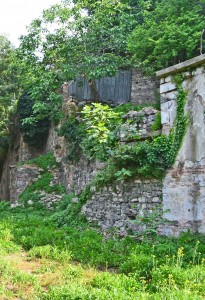 The picture above shows the north side of the raised platform on which the church is built.
The picture above shows the north side of the raised platform on which the church is built.
In July 2019, the church looks much as it has for the last 10 years with fences around announcing the danger and illegality of trespassing.

Posted June 27, 2014 Posted by Adam in Uncategorized
A standard Greek basilica-style church encased in its fortress of walls. The Greek Orthodox Patriarchate was based here (41.037158,28.944924) from 1597 to 1601, whereupon the Patriarch took up residence in the current location.

Posted June 27, 2014 Posted by Adam in Uncategorized
An oasis of peace in the good-natured bustle of Balat. The Orthodox Patriarchate moved here (41°01′45″N 28°57′06″E) in 1601 (after eviction from St Mary Pammakaristos and short stays at Vlach Saray and St Demitrios Xyloportas further down the road) and has been here ever since. The church hasn’t because it burned down and was rebuilt in similar form in 1720.
It has a portative mosaic icon of the Virgin Mary, described as ‘very lovely, by Freely and ‘of inferior work’ by Liddell. This icon probably came from the Church of the Pammakaristos when the Patriarchate moved.
There are many, many relics of great importance and greater authenticity than it is possible for any collection of relics to have.

« Previous Entries Next Entries »
